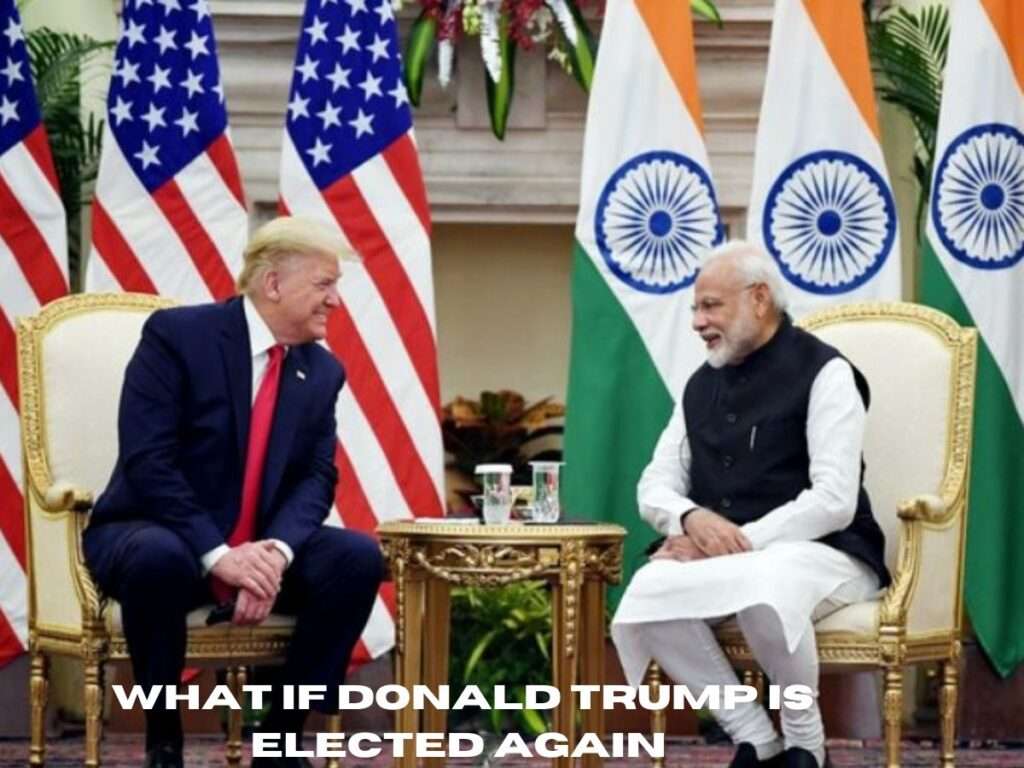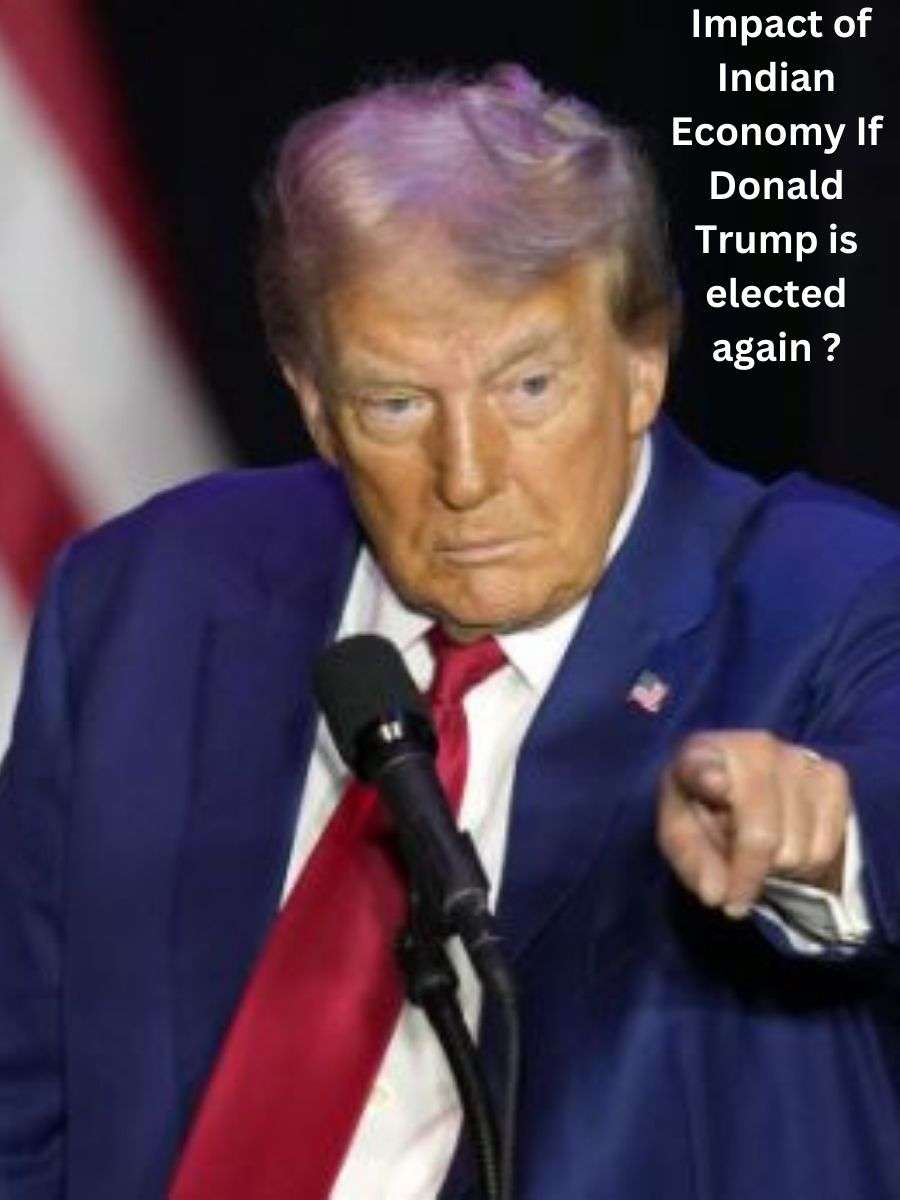The global economy is a highly interconnected system, and any significant policy change by a major power such as the United States can have far-reaching consequences. If former US President Donald Trump returns to office and implements his proposed tariffs, the Indian economy could be affected. According to a Bloomberg Economics report, the tariffs suggested by Trump, which include a 60% tax on Chinese goods and a 20% tariff on all other countries, could reduce India’s GDP by about 0.1% by 2028. This article highlights the wider implications of these tariffs on India’s economy and its trade relations.

Context of US-India trade relations Impact on Indian Economy
India and the United States have a long-standing and strong trade partnership, with bilateral trade set to reach nearly $127 billion in 2022. Despite this, trade tensions have flared up at times, especially during Trump’s first term. He strongly criticised India’s tariffs on US products, particularly on goods such as Harley Davidson motorcycles. The confrontation deepened in 2019 when the US removed India’s developing nation status, under which India could previously export many products duty-free to the US.
The removal of preferential trade benefits led India to impose its own tariffs, further straining the relationship. While trade between the two countries remains important, these disputes underline the delicate nature of their economic relationship.
Trump’s proposed global tariffs and Indian Economy
Trump’s proposed tariffs, which include a staggering 60% duty on Chinese goods and a 20% tax on imports from other countries, are designed to protect US industries and boost domestic production. However, such measures will inevitably impact global trade relationships and disrupt supply chains. For India, which relies heavily on international trade, the effects of these tariffs could be significant. Not only will the cost of exports to the US increase, but imported goods such as electronics, machinery and raw materials from other countries could also become more expensive.
India’s Global Trade Position and Indian Economy
India occupies an important position in global trade, being a major exporter of textiles, pharmaceuticals and IT services. The United States is an important market for many of these sectors. However, India also relies heavily on imports for essential commodities such as crude oil, electronics and capital goods. An increase in tariffs on imports due to Trump’s policies is likely to increase costs for Indian manufacturers, which in turn will increase the prices of goods and services for Indian consumers. Additionally, India’s ability to compete in global markets could be weakened if trade barriers rise.
Potential Impact on Indian Economy and It’s GDP
While the projected impact on India’s GDP – a reduction of 0.1% by 2028 – may seem small, the broader impact could be more profound. Trade disruptions could hurt India’s growth prospects, especially in key industries such as manufacturing and technology. In addition, as the global trade environment becomes more challenging, the country’s ability to increase exports could be hampered. This could lead to slower growth in a variety of sectors, including pharmaceuticals and information technology, both of which are crucial to India’s economy.
Competitiveness challenges for India
The Indian economy and its competitiveness are already under pressure, especially when compared to China, which has a more diversified and robust manufacturing sector. If Trump’s tariffs are implemented, it could exacerbate these challenges, making it harder for India to compete globally. China’s ability to absorb trade shocks due to its scale and influence in global manufacturing could put India at a disadvantage, especially if global trade volumes decline.
Potential retaliation against India
Another potential consequence of Trump’s tariff policy is the risk of reciprocal measures against India. Trump has previously criticised India for high tariffs on US products, and if the proposed tariffs are implemented, India could find itself facing even more trade restrictions from the US. This could further restrict India’s access to the US market, making it even more difficult for Indian businesses to export goods to one of its most important trading partners, and may badly impact the Indian economy.
Impact on Indian manufacturing
The Indian manufacturing sector is likely to be one of the most affected by Trump’s tariffs. The sector relies heavily on imports of machinery, electronics and raw materials, which will become even more expensive under the new trade rules. This could increase production costs for Indian manufacturers, reduce profit margins and potentially lead to job losses in key industries such as automobile manufacturing, electronics and textiles.
Inflation and Consumer Prices in India
An increase in tariffs could also increase inflation in India, as the cost of imported goods would be passed on to consumers. Everyday goods such as electronics, automobiles, and food items could become more expensive, reducing the purchasing power of Indian consumers. Inflationary pressures could slow consumer spending, which is a key driver of India’s economic growth. This situation would be particularly challenging for a country like India, where a large portion of the population is already struggling with rising living costs.
Indian Economy and its counter Response
To counter the effects of Trump’s proposed tariffs, India may need to take a proactive approach. To safeguard the Indian economy, the Modi government could consider increasing subsidies for domestic manufacturing to encourage local production and reduce dependence on imports. Additionally, reducing import duties on essential goods could help ease some of the inflationary pressures, making it easier for businesses to access the materials they need to remain competitive.
Manufacturing Subsidies and Economic Growth
One possible strategy to mitigate the effects of tariffs is to expand manufacturing subsidies. By providing financial incentives to manufacturers, the government can encourage domestic production and reduce the economy’s dependence on imports. Economists suggest that a combination of a 4% production incentive and a 1% reduction in import duties could increase India’s GDP by 0.5% from the baseline, which could mitigate some of the negative effects of tariffs.
Import duty reduction as a strategic response
Reducing import duties could also be an effective tool for India to deal with the challenges posed by Trump’s tariffs. By making imported goods cheaper, the government could help manufacturers reduce their production costs, thereby keeping consumer prices stable. Additionally, reducing duties could improve India’s competitiveness in the global market, making it easier for businesses to expand their export activities despite the challenging trade environment.
Diversifying trade relationships
One of the long-term solutions for India to protect itself from the impact of Trump’s tariffs is to diversify its trade partnerships. Strengthening economic ties with countries outside the US such as the EU, Japan and ASEAN countries can provide India with alternative markets for its goods. By expanding its trade network, India can reduce its dependence on the US and protect the Indian economy and its interests in an increasingly protectionist global trade landscape.
Long-term economic outlook for India
Trump’s planned tariffs are anticipated to have a minor short-term impact on Indian economy, but if trade tensions increase globally, the long-term impacts may be more substantial. India’s ability to adapt to these challenges will depend on its economic policies, particularly those aimed at boosting domestic manufacturing and diversifying trade relationships. India can reduce the negative effects and keep moving forward with its Indian economy if it can effectively handle these challenges.
Frequently Asked Questions
How will Trump’s tariffs affect India’s GDP?
The proposed tariffs could cause India’s GDP to shrink by 0.1% by 2028.
Which sectors in India will be most affected?
Manufacturing, especially import-dependent sectors such as electronics and automobiles, will face the biggest challenges.
How can India mitigate the impact of tariffs?
By increasing subsidies for manufacturing, reducing import duties and diversifying trade ties.
Why is India vulnerable to global tariffs?
India is heavily dependent on both imports and exports, making it vulnerable to changes in global trade policies.
What are the long-term risks for India?
Long-term risks include lower competitiveness, slower export growth and inflationary pressures.
Can India diversify its trade ties to reduce dependence on the US?
Yes, strengthening ties with other major economies such as the EU, Japan and ASEAN countries can help reduce dependence on the US.
ZERODHA 1) : https://zerodha.com/open-account?c=EJ4366
Angelone 2) : https://tinyurl.com/2gloc3g6 or
Upstox3): https://link.upstox.com/9w4tNo1rK8au7VK47









